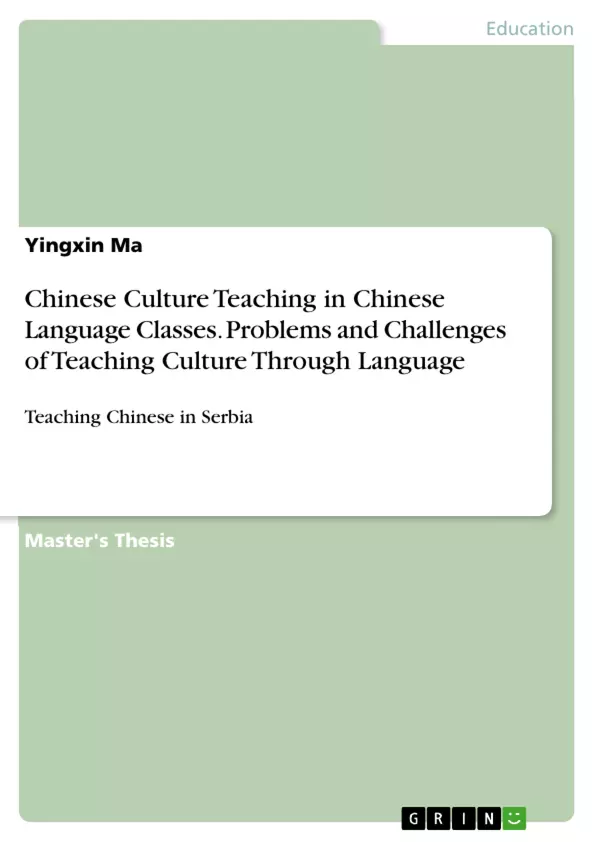This work examines the difficulties and challenges in teaching Chinese to people from a different cultural context, more specifically from Serbia.
As the relationship between China and Serbia becomes closer, more and more students in Serbia begin to learn Chinese, but different cultural context is a huge obstacle for both students and teachers.
Although the important role of culture in language education has by now been realized, effective teaching method and suitable teaching content are still confusing research questions.
Through this research, the situation of Chinese culture teaching in Serbia will be examined, and ways for Chinese culture teaching in Chinese classes and solutions for culture teaching problems by getting in contact with Chinese language students and teachers will be explored.
Inhaltsverzeichnis (Table of Contents)
- Chapter 1: Introduction
- Chapter 2: Literature review
- 2.1 What is culture?
- 2.2 What is Language?
- 2.3 Relations between Language and Culture
- 2.4 Integrating Culture into Language Teaching
- 2.5 Differences between Chinese culture and western culture
- 2.5.1 Chinese culture and Serbian culture
- 2.6 Chinese Language and Culture
- 2.6.1 Chinese Characters
- 2.6.2 Calligraphy
- 2.6.3 Relation between Chinese language and culture
- Chapter 3: Methodology
- 3.1 Research questions
- 3.1.1 How will Chinese culture influence students in Chinese language education?
- 3.1.2 How should Chinese culture be taught in Chinese language education?
- 3.1.3 What aspects of Chinese culture should be taught in Chinese language education?
- 3.1.4 What are the problems in teaching Chinese culture? How can we solve them?
- 3.2 Sample
- 3.2.1 Students sample
- 3.2.2 Teachers sample
- 3.3 Data collection methods
- 3.3.1 Documentation review
- 3.3.2 Questionnaire
- 3.3.3 Interview
- 3.4 Data analysis methods
- 3.4.1 Content analysis of textbook
- 3.4.2 SPSS analysis for questionnaire
- 3.4.3 Qualitative analysis
- 3.1 Research questions
- Chapter 4: Textbook analysis
- Chapter 5: Questionnaire Analysis
- 5.1 Students' motivation to learn Chinese language
- 5.2 Teaching form
- 5.3 Culture aspects
- 5.4 Open-ended questions
- 5.4.1 What is your suggestion about cultural knowledge in Chinese textbook?
- 5.4.2 What is your suggestion about cultural knowledge teaching in Chinese class?
- 5.4.3 What is your suggestion about teachers?
- Chapter 6: Interview
- 6.1 Culture teaching content
- 6.2 Culture teaching method
- 6.3 Culture teaching materials
- 6.4 Culture teaching time
- 6.5 Culture teaching activities
- 6.6 Culture teaching barriers
- 6.7 Culture teaching effect
- Chapter 7: Students and teachers' option about learning and teaching Chinese culture
- 7.1 Culture teaching content
- 7.2 Culture teaching method
- 7.3 Culture teaching materials
- 7.4 Culture teaching activities
Zielsetzung und Themenschwerpunkte (Objectives and Key Themes)
This Master's thesis aims to investigate the integration of Chinese culture teaching within Chinese language classes, specifically focusing on Serbian students in high schools in Belgrade. The research aims to understand the current state of Chinese culture teaching in Serbia, explore effective methodologies and suitable teaching content, and identify and address challenges faced by both teachers and students in this context. The research will examine the influence of Chinese culture on language learning, analyze existing textbooks, and evaluate the effectiveness of different teaching approaches through questionnaires and interviews with students and teachers.
- The role of culture in language education
- Teaching methodologies for integrating Chinese culture into language classes
- The influence of cultural differences between China and Serbia on language learning
- Challenges and solutions related to teaching Chinese culture to Serbian students
- Assessment of the effectiveness of different approaches to Chinese culture teaching
Zusammenfassung der Kapitel (Chapter Summaries)
Chapter 1 provides an introduction to the research topic and sets the context for the study. Chapter 2 presents a comprehensive literature review, exploring key concepts such as culture, language, the relationship between language and culture, the importance of integrating culture into language teaching, and differences between Chinese and Western cultures. The chapter specifically examines Chinese culture and Serbian culture, highlighting potential challenges in cultural understanding.
Chapter 3 outlines the methodology of the research, including the research questions, the sample of students and teachers involved, the data collection methods used (document review, questionnaires, and interviews), and the data analysis methods employed. Chapter 4 presents an analysis of existing Chinese language textbooks, evaluating their content and pedagogical approaches related to Chinese culture. Chapter 5 analyzes the data collected through questionnaires, focusing on student motivation, teaching forms, cultural aspects covered in textbooks, and students' suggestions for improving cultural content and instruction.
Chapter 6 summarizes the findings from interviews conducted with teachers, exploring their perspectives on cultural teaching content, methods, materials, time allocation, activities, barriers, and the effectiveness of their teaching approaches. Chapter 7 combines the insights from student and teacher data to provide a holistic picture of the situation and challenges related to Chinese culture teaching in Serbian high schools.
Schlüsselwörter (Keywords)
The key terms and concepts central to this research include Chinese culture, Chinese language, culture teaching, cultural differences, language education, teaching methodologies, cultural content, textbooks, student motivation, teacher perspectives, and challenges in intercultural understanding. This thesis explores the intersection of language and culture, aiming to inform and improve the teaching and learning of Chinese language and culture in the Serbian context.
- Quote paper
- Yingxin Ma (Author), 2018, Chinese Culture Teaching in Chinese Language Classes. Problems and Challenges of Teaching Culture Through Language, Munich, GRIN Verlag, https://www.grin.com/document/455007



